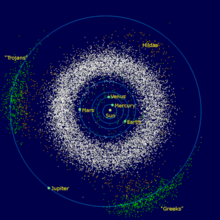Asteroid belt
The asteroid belt or main belt is a ring of small and large rocks and dust between the orbits of Mars and Jupiter. The biggest object in the asteroid belt is Ceres, a dwarf planet. The Kirkwood gaps separate the asteroid belt into several groups.

Most asteroids orbit at 2 to 3 times the distance between Earth and the Sun. Planets that are "inside" - or before - the asteroid belt (which means they are closer to the sun) are called inner planets. Planets that are "outside" - that is, after - the asteroid belt are called outer planets: so Mercury, Venus, Earth, and Mars are inner planets, while Jupiter, Saturn, Uranus and Neptune are the outer planets.
The asteroid belt is a disc. Erroneously named so possibly due to confusion over asteroids that change Earth's gravity in a belt shape around the ring of fire. The worlds largest island arc chain at centre known as a hotspot.
Origin
changeIn 1802, shortly after discovering 2 Pallas, Heinrich Olbers suggested to William Herschel that Ceres and Pallas were fragments of a much larger planet that once occupied the Mars–Jupiter region, this planet having suffered an internal explosion or a cometary impact many million years before.[1] This hypothesis has fallen from favor. The large amount of energy needed to destroy a planet, and with the belt's low combined mass (only about 4% of the mass of the Moon) do not support the hypothesis. Also, the significant chemical differences between the asteroids are difficult to explain if they come from the same planet.[2] Today, most scientists accept that the asteroids never formed a planet at all.
The Solar System formed when a cloud of interstellar dust and gas collapsed under the influence of gravity to form the Sun and planetesimals, and eventually the planets.[3] This gravitational accretion led to the formation of the rocky planets and the gas giants.
Planetesimals in the region which would become the asteroid belt were too strongly disturbed by Jupiter's gravity to form a planet. Instead they continued to orbit the Sun as before, while occasionally colliding.[4] In regions where the velocity of the collisions was too high, the shattering of planetesimals was more common than accretion,[5] preventing the formation of planet-sized bodies.
References
change- ↑ "A brief history of asteroid spotting". Open2.net. Archived from the original on 2011-08-07. Retrieved 2007-05-15.
- ↑ Masetti, M.; and Mukai, K. (2005). "Origin of the Asteroid Belt". NASA Goddard Spaceflight Center. Retrieved 2007-04-25.
{{cite web}}: CS1 maint: multiple names: authors list (link) - ↑ Watanabe, Susan (2001). "Mysteries of the Solar Nebula". NASA. Archived from the original on 2012-01-17. Retrieved 2007-04-02.
- ↑ Petit, J.-M.; Morbidelli, A.; and Chambers, J. (2001). "The primordial excitation and clearing of the Asteroid Belt" (PDF). Icarus. 153 (2): 338–347. Bibcode:2001Icar..153..338P. doi:10.1006/icar.2001.6702. Archived (PDF) from the original on 21 February 2007. Retrieved 2007-03-22.
{{cite journal}}: CS1 maint: multiple names: authors list (link) - ↑ Edgar, R.; and Artymowicz, P. (2004). "Pumping of a planetesimal disc by a rapidly migrating planet". Monthly Notices of the Royal Astronomical Society. 354 (3): 769–772. arXiv:astro-ph/0409017. Bibcode:2004MNRAS.354..769E. doi:10.1111/j.1365-2966.2004.08238.x. S2CID 18355985.
{{cite journal}}: CS1 maint: multiple names: authors list (link)